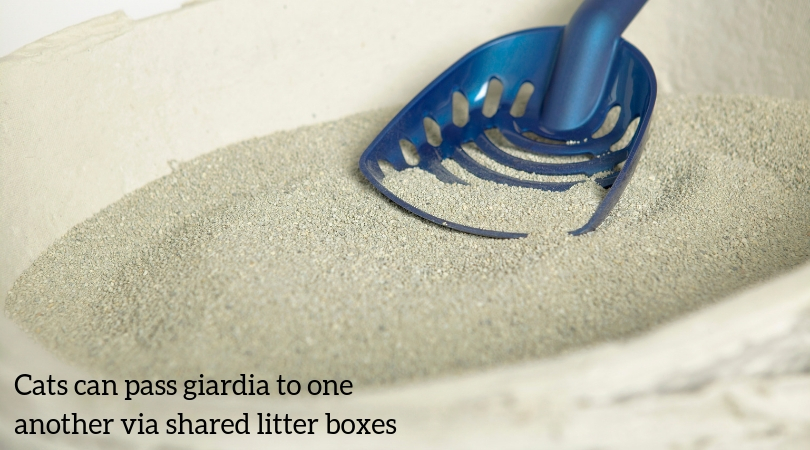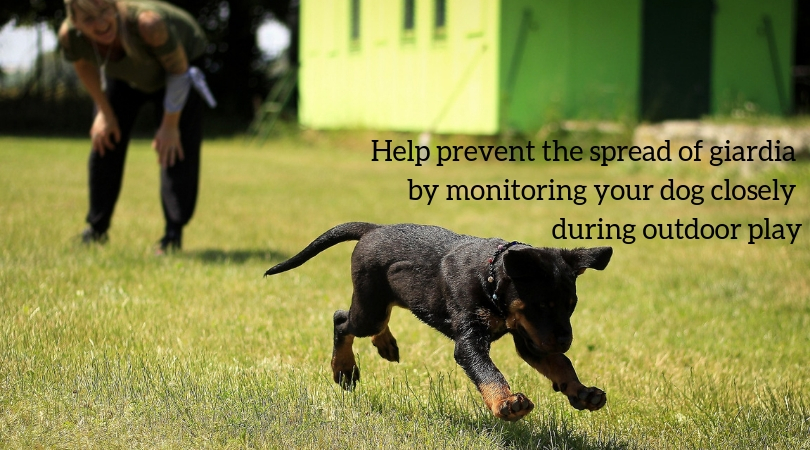What is Giardia?
It’s possible you’re not familiar with this nasty parasite or think it’s limited to foreign countries. However, giardia is a common intestinal parasite throughout the U.S. as well as abroad. Mud puddles, unclean rivers, and even contaminated grass can all spread this infection.
According to the Companion Animal Parasite Council (CAPC), “Giardia is passed in the feces of animals in the form of a cyst that is resistant to many environmental extremes. These cysts are scattered through the environment in feces or fecal-contaminated water. These cysts are infectious when passed, and upon ingestion by the next host, the encysted trophozoites emerge from the cysts in the intestinal tract. Within the intestine, the trophozoites feed and multiply. Some trophozoites will then form a cyst wall around themselves, and those costs will be passed in the feces to continue the cycle.”
Now, the existence of the parasite isn’t a problem, but if your dog or cat ingests it, they can get sick.
How Can Your Dog or Cat Get Giardia?
The most common method of contracting giardia is by eating or drinking something contaminated with feces. For example, your pet can get giardia by drinking feces-contaminated water, eating grass, chewing sticks, or even eating poop. It’s gross, but we know they do it!
Once the parasite is in your pet’s system, it can be spread to other animals. So if you have a multi-pet household, you’ll want to contact your veterinary team and seek treatment right away. And yes, cats are susceptible as well. If you have cats who share litter boxes, that’s one way they can pass it to one another.

What Are the Symptoms of Giardia?
Sometimes, your dog or cat seems asymptomatic (not showing symptoms); however, unexplained diarrhea, weight loss, and/or an unhealthy coat can be hints that something is wrong.
“The parasite inhibits your dog’s ability to properly absorb nutrients, water, and electrolytes, which leads to diarrhea and weight loss. Diarrhea can be intermittent or continuous, especially in puppies, and failure to diagnose and treat the disease can lead to severe weight loss and even death in extreme cases. The disease is particularly dangerous for puppies, senior dogs, and dogs with compromised immune systems.” (Source)
How Do You Treat Giardia?
Your veterinarian will need at least one stool sample to review under a microscope.
“Giardia cysts can be identified in a fecal smear under a microscope. Since cysts are shed in stools sporadically, several different fecal samples may be needed for positive identification. Special stains may be needed, as the organism can sometimes be elusive.” (Source)
There are a few medications that your veterinarian may prescribe, though Metronidazole (Flagyl) or Fenbendazole are two of the most common.
How Can You Prevent Giardia?
No one wants their pet to be sick, yet it can be tough to guard against an illness like giardia. We recommend precautions like always having fresh water available for your pet and picking up after them quickly so they (or other pets) don’t eat the poop.

Also, try to monitor them when you’re outside. We know that dogs, especially, explore the world through their mouths. Forests, fields, and dog parks sometimes offer less than sanitary opportunities, so keep an eye on them as best you can.
Giardia in Dogs

What Is Giardia in Dogs?
Giardia is a single-celled microscopic parasite. It can live in the intestines of dogs (and other animals, including cats and humans) and cause severe gastrointestinal disease.
Giardia in dogs is spread by fecal-contaminated water, food, or soil. It is possible for you to catch Giardia from your infected dog, so you must practice safe hygiene habits when caring for an infected pet, such as vigilant handwashing and decontaminating your home and all the areas your dog has access to.
Symptoms of Giardia in Dogs
Giardia in dogs is a disease that causes a lot of watery diarrhea. Beyond diarrhea, Giardia symptoms in dogs can include vomiting, excess foul-smelling gas, decreased appetite, decreased energy, and frequent urge to poop.
It is also worth noting that dogs (and other animals, for that matter) can have Giardia present in their intestines and be subclinical, which means they are asymptomatic. Since the test for Giardia is not routinely run in healthy dogs, we’re not sure how often this is the case.
The possibility of otherwise healthy dogs carrying Giardia is another reason why hygiene around animal feces is so important beyond the “ick factor” of handling poop.
Causes of Giardia in Dogs
Found in each corner of the United States and worldwide, Giardia cysts (outer shells that allow the parasite to live outside a host) must be ingested to cause infection.
Dogs are infected by eating food or drinking water that carries the cysts, or from ingesting infected feces directly.
Ingesting feces does not always mean eating poop from the ground. Ingestion can also happen when your dog sniffs other dogs’ hind ends (the most common greeting between dogs), then licks their nose.
Contaminated soil and plants are another sources of infection for dogs.
Dogs may also hunt and kill contaminated prey and become infected in this manner.
How Vets Diagnose Giardia in Dogs
Your veterinarian will gather a complete history and conduct a physical exam to evaluate your dog’s overall health and hydration, as well as check for intestinal pain, gas, and possible Giardia exposure.
To check for evidence of Giardia infection, called Giardiasis, your veterinarian will likely recommend:
- A fecal test for routine intestinal parasites (many veterinarians will also send a fecal sample to the lab for further testing)
- A parvovirus test to eliminate this deadly yet preventable virus as a possible cause
- A quick, in-house “snap test” or microscope evaluation
Treatment for Giardia in Dogs
Medications to get rid of Giardia are readily available and affordable. Metronidazole, an antibiotic, is most often prescribed. Fenbendazole is used often for Giardia also.
The disease may take multiple rounds of treatment because it can be hard to completely remove it from your home and prevent reinfection, but many times, the infection is cleared after one round.
Additional medications may be prescribed depending on the severity of the infection and your dog’s condition.
Dehydrated dogs and puppies may benefit from subcutaneous fluid therapy (fluids injected under the skin), administration of electrolytes, and injectable vitamins.
If your dog is moderate to severely dehydrated, it could require hospitalization for intravenous fluid therapy.
Recovery and Management of Giardia in Dogs
There is no such thing as immunity against future Giardia infections for dogs that have been infected. In fact, dogs that have just cleared a Giardia infection can easily be reinfected.
For this reason, you must disinfect all living areas your dog has access to. Ammonia, diluted bleach solution, or steam cleaning can be effective against the cysts. Promptly pick up all of your dog’s poop and dispose of it (whether your dog poops on walks or in your yard).
These challenges with thorough environmental disinfection and maintenance make this parasite a tough one to eliminate. Under the right conditions, contaminated soil or inside areas can remain infectious for months, so you need to rigorously clean and avoid those areas when at all possible.
If you have other pets in the household, please tell your vet so that you can discuss if medications should be administered to the other animals as a preventive measure.
Since Giardia is so contagious, make sure you follow up with rechecks at the vet. Multiple negative tests are required before you can relax and rest easy.
If your family includes a baby who crawls around or eats things off the floor or an immunocompromised person, the vet will likely require more negative Giardia tests to ensure the eradication of the parasite.
Here are some additional tips for environmental management and prevention of Giardia:
Schedule a stool check and Giardia testing before bringing a new pet home and introducing them to your other animals.
Use a monthly heartworm preventative that also targets gastrointestinal parasites to keep your dog in tip-top shape.
Keep outdoor sandboxes covered when not in use.
Maintain a regular checkup regimen with your vet, and always opt in for fecal parasite testing.
If possible, prevent your dog from hunting and eating rodents and other small animals.


No comments:
Post a Comment